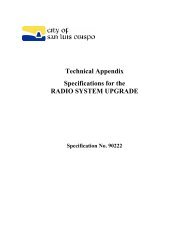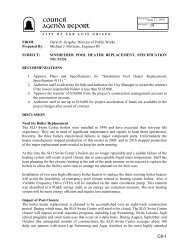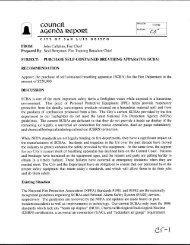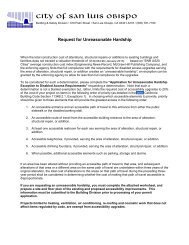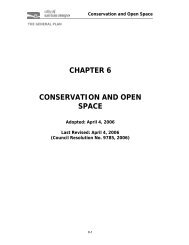Drainage Design Manual - the City of San Luis Obispo
Drainage Design Manual - the City of San Luis Obispo
Drainage Design Manual - the City of San Luis Obispo
Create successful ePaper yourself
Turn your PDF publications into a flip-book with our unique Google optimized e-Paper software.
Detention for <strong>the</strong> 10-year design storm may be permitted with specific approval <strong>of</strong> <strong>the</strong> <strong>City</strong>Engineer or County Public Works Director. The design criteria for a 10-year storm would be <strong>the</strong>same as <strong>the</strong> requirements <strong>of</strong> a 100-year storm, as noted above, with <strong>the</strong> exception <strong>of</strong> <strong>the</strong> depth <strong>of</strong>water stored. The depth <strong>of</strong> water detained cannot exceed .150 mm (0.5 ft) at any location in <strong>the</strong>parking lot under <strong>the</strong> 10-year design storm.9.1.4 Regional Facilities vs. On-Site DetentionIf storage facilities are planned for an individual site, ra<strong>the</strong>r than as a component <strong>of</strong> an overallregional plan, <strong>the</strong> storage is referred to as On-site Detention Facility. Such on-site facilities aredesigned to control short, intense storms that produce <strong>the</strong> greatest peak flows. The facilitiestypically are small in scale and can be used when regional detention is not available or if on-sitestorage is necessary to reduce peak discharge for downstream pipes, culverts, ditches, or streams.Facilities designed as a component <strong>of</strong> a Master <strong>Drainage</strong> Plan are classified as a RegionalDetention Facility. Generally, a <strong>Drainage</strong> Master Plan that incorporates such regional storagefacilities can produce more economical and effective mitigation <strong>of</strong> increase run<strong>of</strong>f than ispossible with numerous small detention basins. Regional facilities typically are larger than onsite,privately owned basins, and are designed to control systematically run<strong>of</strong>f from <strong>the</strong> totalwatershed. Detention facilities identified within <strong>the</strong>se regional drainage studies must meet allapplicable drainage performance requirements. Any variation from <strong>the</strong>se standards requiresprior approval from <strong>the</strong> <strong>City</strong> or County.Coordinated Regional Detention Facilities that take into account <strong>the</strong> entire watershed area arepreferred over individual stormwater facilities. When a regional drainage study has beenconducted and regional basins are designed, <strong>the</strong> regional facility will always take precedenceover local basin design. When necessary, on-site detention can be provided on a temporary basisuntil a Regional Detention Facility is built, and removed subsequent to completion <strong>of</strong> <strong>the</strong>Regional Detention Facility.9.1.5 LocationWhen choosing a location for a basin, <strong>the</strong> following factors should be taken into consideration:• Topography: Check for obvious low and high points in <strong>the</strong> area. The greater <strong>the</strong>excavation, <strong>the</strong> higher <strong>the</strong> costs. Also, look for natural neckings <strong>of</strong> <strong>the</strong> watershed if adam is necessary.• Location in <strong>the</strong> Watershed: Locate <strong>the</strong> basin far enough down in <strong>the</strong> reaches <strong>of</strong> <strong>the</strong>watershed to most effectively reduce <strong>the</strong> peak flow by intercepting <strong>the</strong> greatestnumber <strong>of</strong> tributaries to <strong>the</strong> main drainage channel. However, a basin located too lowin <strong>the</strong> watershed may require upstream channel improvements. The timing <strong>of</strong> outflowhydrographs should be examined closely for basins low in <strong>the</strong> watershed.• A basin located too high in <strong>the</strong> watershed allows all downstream lands to drainuncontrolled, which will increase <strong>the</strong> total flow to an undesirable level. This maySLO Creek <strong>Drainage</strong> <strong>Design</strong> <strong>Manual</strong> 101 February 2003




